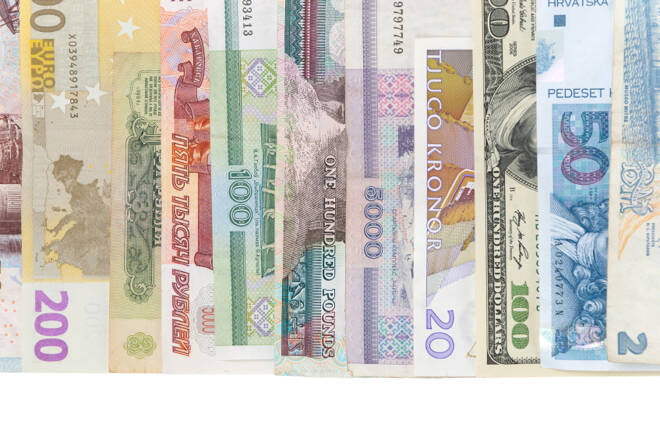Advertisement
Advertisement
Jump in Yields Pressure Aussie, Kiwi While BOJ Decision Underpins Yen
By:
While another surge in Treasury yields dominated the trade, central bank activity in the US, Australia and Japan also had a say in the price action.
The major Asia-Pacific currencies finished mixed by mostly lower last week with the Australian and New Zealand Dollars pressured by rising Treasury yields, while surprising, the Japanese Yen posted a small gain versus the U.S. Dollar.
While another surge in U.S. Treasury yields dominated the trade, central bank activity in the United States, Australia and Japan also had a say in the price action, while in New Zealand, fresh data served as a reminder that the economy is still be affected by the pandemic.
Price Action Driven by Treasury Yield Jump, Fed Comments
The 10-year U.S. Treasury yield jumped above 1.7% on Thursday, its highest level in more than a year, despite reassurance from the Federal Reserve that it had no plans to hike interest rates anytime soon, nor taper its bond-buying program. The news put pressure on the Aussie and Kiwi, while Yen traders failed to react to a surge in the U.S. Dollar.
On Wednesday, the Federal Reserve kept rates anchored near zero and maintained the current pace of asset purchases, following the conclusion of this week’s meeting. Officials also upgraded expectations for GDP growth and inflation and cut estimates for the unemployment rate. Additionally, more members foresee rate hikes in coming years, but not enough to change the forecast for none through at least 2023.
Australian Dollar
The Reserve Bank of Australia (RBA) last week dismissed rate hike talks while recommitting to its three-year yield curve control target at 0.1%. On Tuesday, minutes of its March 2 meeting showed policymakers were not expecting inflation and wage growth to rise material before 2024 at the earliest.
The AUD/USD settled last week at .7746, down 0.0011 or -0.14%.
Last Wednesday, Assistant Governor Chris Kent reiterated the RBA’s lower-for-longer rate view while signaling monetary policy will not be used to control asset price gains.
In other news, Australian employment surpassed all expectations to jump for a fifth consecutive month in February while the jobless rate fell much more rapidly than expected, in yet another sign the country’s economy was moving in the right direction.
Figures from the Australian Bureau of Statistics (ABS) on Thursday showed employment rose a net 88,700 in February, on top of a roughly 29,000 gain in January. Analysts had forecast a 30,000 increase.
The jobless rate dropped to 5.8%, from 6.4%, far better than market forecasts of 6.3% and down from a peak of 7.5% in July.
The AUD/USD moved lower on the news because the strong data challenges the RBA’s lower-for-longer monetary policy pledge, triggering a jump in the local dollar.
New Zealand Dollar
New Zealand’s economy contracted in the final quarter of last year, raising concern of a second recession and quashing market talk that the country’s central bank may look to hike interest rates sooner.
The NZD/USD settled last week at .7164, down 0.0012 or -0.16%.
Gross Domestic Product (GDP) fell 1.0% in the three months through to December, Statistics New Zealand said on Thursday, short of a Reuters poll forecast of 0.1% growth and below the Reserve Bank of New Zealand’s (RBNZ) flat estimate.
Annual GDP fell 0.9%, Statistics New Zealand said, compared with analyst expectations of a 0.5% rise.
Japanese Yen
The Bank of Japan (BOJ) loosened its grip on long-term bond yields and laid the groundwork to taper its huge asset purchases, as part of steps to make its stimulus program sustainable enough to weather a prolonged battle to fire up inflation.
Last week, the USD/JPY settled at 108.884, down 0.150 or -0.14%.
The BOJ left unchanged its 0% target for 10-year bond yields. But it clarified that long-term yields can move up and down 0.25% around the target, slightly more than the implicit 0.2% level that markets had seen as the BOJ’s line in the sand.
The move is aimed at allowing yields to fluctuate more and breathe life back into a market made dormant by the BOJ’s dominance. But the BOJ stressed the priority was to keep yields “stably low” as the economy feels the damage from COVID-19.
The BOJ won’t try to prevent yields from falling below the band too rigidly. But it will act forcefully to prevent sharp rises in yields with a new weapon – a “special” operation under which it will buy unlimited amounts of bonds for consecutive days at a set price.
For a look at all of today’s economic events, check out our economic calendar.
About the Author
James Hyerczykauthor
James Hyerczyk is a U.S. based seasoned technical analyst and educator with over 40 years of experience in market analysis and trading, specializing in chart patterns and price movement. He is the author of two books on technical analysis and has a background in both futures and stock markets.
Advertisement
